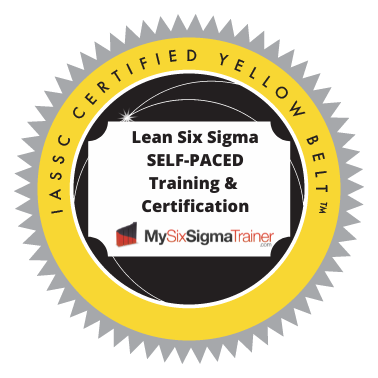
My Six Sigma Trainer
Lean Six Sigma Yellow Belt Certification
* IASSC Certification Exam INCLUDED
CLSSGB | IASSC Exam Certification Online Training - Lean Six Sigma Yellow Belt
The IASSC Certified Lean Six Sigma Yellow Belt (ICYB) is a professional who is well versed in the foundational elements of the Lean Six Sigma Methodology, who leads limited improvement projects and / or serves as a team member as a part of more complex improvement projects lead by a Certified Green Belt or Certified Black Belt, typically in a part-time role.


Lean Six Sigma Yellow Belt Certification
Options available during checkout
EXAM CERTIFICATION
IASSC IASSC EXAM Certification with PeopleCert [includes $25 processing fee] +$375
Mock Lean Six Sigma Project +$600
- No PREQUISITES
- Learn Basic Lean Six Sigma Tools
- Program Length 21 hrs
[Can be done in 5 hours per week for 4 weeks or 1 month]. This time includes assigned reading, videos lessons, exercises, quizzes, assignments, comprehensive final exam, practice exam for IASSC certification. - Yellow Belt ... is best suited for early career or executives. Yellow Belts support other Belts or act as project champion.
- Includes Student Manual - Your notes are already done for you!
- Includes graded exercises and assignments that are submitted with feedback from our Certified Master Black Belt instructors. Plus answers to questions [unlimited] submitted though learning portal.
- Get the IASSC Certification by passing the IASSC Certification Exam with PeopleCert [includes $25 processing fee]. Pay now ... request your voucher when you complete the course. Expires one year after issuance. +$275.
- Get the Holbus Training Group Certificate of Completion when you pass our comprehensive open book final. Take as many times as you would like then request your certificate when you are ready.
- Learn Anywhere! Courses are 100% online & 100% Self Paced.
- Take as long as you need to complete the course. You have 12 Months access to our E-learning portal.
- EXPERIENTIAL LEARNING: Bring it all together with a Capstone Simulation of a real life Lean Six Sigma Case Study [Mock Project]. Includes deliverables, templates, essay for a simple but complete Lean Six Sigma project that is graded and feedback provided by Certified Master Black Belt Instructors +$600
- Minitab or SigmaXL statistical software is required to complete the course. Trial versions are available at each respective websites.
- PAYMENT PLANS AVAILABLE
or executive
overview
Certified Lean Six Sigma Yellow Belt Certification
A Lean Six Sigma Yellow Belt possesses a thorough understanding of the elementary aspects of the Lean Six Sigma Method including competence in the subject matters contained within the phases of Define, Measure, and Control (DMC) as defined by the IASSC Lean Six Sigma Yellow Belt Body of Knowledge. A Lean Six Sigma Yellow Belt understands how to implement, perform, interpret and apply Lean Six Sigma in a skilled yet limited and / or supportive context.

Certification Testing
///////////////////////
The IASSC Certified Lean Six Sigma Yellow Belt Exam™ is a 60 question, closed book, proctored exam with a 2 hour allotted time.
The Exam contains multiple-choice and true/false questions from each section of the IASSC Lean Six Sigma Yellow Belt Body of Knowledge and is administered in more than 8,000 Testing Centers located within 165 countries throughout the world and through the IASSC Web-Based On-Demand testing system and by hundreds of IASSC Accredited Providers.
Certification Testing
///////////////////////
The IASSC Certified Lean Six Sigma Yellow Belt Exam™ is a 60 question, closed book, proctored exam with a 2 hour allotted time.
The Exam contains multiple-choice and true/false questions from each section of the IASSC Lean Six Sigma Yellow Belt Body of Knowledge and is administered in more than 8,000 Testing Centers located within 165 countries throughout the world and through the IASSC Web-Based On-Demand testing system and by hundreds of IASSC Accredited Providers.


LSSYB Requirements
///////////////////////
In order to achieve the professional designation of IASSC Certified Yellow Belt (IASSC-CYB™) from the International Association for Six Sigma Certification, candidates must sit for the IASSC Certified Lean Six Sigma Yellow Belt Exam and achieve a minimum score of 230 points out of a total potential of 300 points.
There are no prerequisites required in order to sit for the IASSC Certified Lean Six Sigma Yellow Belt Exam. For more about this see FAQ’s and the IASSC position on knowledge and application.
Purchase of a Black Belt Certification Exam Voucher when you sign up for your training.
Preparation
///////////////////////
For those who wish to sit for the exam it is recommended, but not required, that Lean Six Sigma training is obtained through a qualified institution, Lean Six Sigma trainer or corporate program prior to sitting for the IASSC Certified Lean Six Sigma Yellow Belt Exam.


Preparation
///////////////////////
For those who wish to sit for the exam it is recommended, but not required, that Lean Six Sigma training is obtained through a qualified institution, Lean Six Sigma trainer or corporate program prior to sitting for the IASSC Certified Lean Six Sigma Yellow Belt Exam.

Lean Six Sigma Yellow Belt Certification
///////////////////////
Upon successful achievement, Professionals will receive IASSC Yellow Belt Certification issued by the International Association for Six Sigma Certification™, the only independent third-party Certification Association within the Lean Six Sigma Industry.
IASSC Certification is recognized perpetually. In accordance with the IASSC Recertification Policy, effective March 1, 2017, a classification system recognizes certifications as “Current” for a period of three years and defines regulations for maintaining such Status.
An IASSC Certified Yellow Belt is issued a Certificate (Electronic or Hard Copy) along with a Certification Number, added to the Official IASSC Certification Register and granted the right to use the IASSC Certification Marks and Titles; as professional designation which may be used in resumes and public profiles such as LinkedIn, consistent with the IASSC Marks Use Policy.

Lean Six Sigma Body of Knowledge
The IASSC Universally Accepted Lean Six Sigma Body of Knowledge (ILSSBOK) is an embodiment of the consensus of what industry expects of a Lean Six Sigma Black Belt, Lean Six Sigma Green Belt and a Lean Six Sigma Yellow Belt.
The ILSSBOK is the result of research that was conducted over a two year period with the assistance of the leading industry publication house. The goal of this project was to characterize the standard knowledge requirements that are universally expected of a Lean Six Sigma Black Belt, Lean Six Sigma Green Belt and a Lean Six Sigma Yellow Belt. With input from 1000’s of Deployment Leaders, Master Blacks Belts, Black Belts and Green Belts from 100’s of companies and industry sectors the ILSSBOK is truly the Voice of the Industry.
This is a significant breakthrough, for the first time in the history of the Lean Six Sigma the industry itself has defined what it deems is as a relevant and practical version of the knowledge expectations of a Lean Six Sigma Black Belt, Green Belt and Yellow Belt. Today, IASSC continues this research and accepts ongoing industry feedback to ensure the standards continue to accurately represent the market expectations.
The ILSSBOK consists of five primary sections each of which is broken into sub-categories. This Body of Knowledge serves as the basis for what many of today’s leading Lean Six Sigma companies consider to be standard and expected knowledge requirements of a Lean Six Sigma Black Belt, Lean Six Sigma Green Belt and Lean Six Sigma Yellow Belt. This body of knowledge also serves as the foundation upon which IASSC Certification examinations are built.
The IASSC Certified Black Belt Exam is constructed based on the topics within the Body of Knowledge listed below. Questions may test up to the complexity level of “Analyze” as defined by Levels of Cognition based on Bloom’s Taxonomy – Revised (2001). More about Blooms Taxonomy may be found in the FAQ’s section.
My Six Sigma training covers 100% - IASSC Universally Accepted Lean Six Sigma Body of Knowledge for Yellow Belts
1.0 Define Phase
///////////////////////
- 1.1 The Basics of Six Sigma
- 1.1.1 Meanings of Six Sigma
- 1.1.2 General History of Six Sigma & Continuous Improvement
- 1.1.3 Deliverables of a Lean Six Sigma Project
- 1.1.4 The Problem Solving Strategy Y = f(x)
- 1.1.5 Voice of the Customer, Business and Employee
- 1.1.6 Six Sigma Roles & Responsibilities
- 1.2 The Fundamentals of Six Sigma
- 1.2.1 Defining a Process
- 1.2.2 Critical to Quality Characteristics (CTQ’s)
- 1.2.3 Cost of Poor Quality (COPQ)
- 1.2.4 Pareto Analysis (80:20 rule)
- 1.2.5 Basic Six Sigma Metrics
- a. including DPU, DPMO, FTY, RTY Cycle Time; deriving these metrics
1.0
2.0 Measure Phase
///////////////////////
- 2.1 Process Definition
- 2.1.1 Cause & Effect / Fishbone Diagrams
- 2.1.2 Process Mapping, SIPOC, Value Stream Map
- 2.1.3 X-Y Diagram
- 2.1.4 Failure Modes & Effects Analysis (FMEA)
- 2.2 Six Sigma Statistics
- 2.2.1 Basic Statistics
- 2.2.2 Descriptive Statistics
- 2.2.3 Normal Distributions & Normality
- 2.2.4 Graphical Analysis
2.0
3.0 Analyze Phase
///////////////////////
- 3.1 Patterns of Variation
- 3.1.1 Multi-Vari Analysis
- 3.1.2 Classes of Distributions
- 3.2 Inferential Statistics
- 3.2.1 Understanding Inference
- 3.2.2 Sampling Techniques & Uses
- 3.2.3 Central Limit Theorem
3.0
Levels of Cognition based on Bloom’s Taxonomy – Revised (2001)
These levels are from “Levels of Cognition” (from Bloom’s Taxonomy – Revised, 2001). They are listed in order from the least complex to the most complex.
Remember
Recall or recognize terms, definitions, facts, ideas, materials, patterns, sequences, methods, principles, etc.
Understand
Read and understand descriptions, communications, reports, tables, diagrams, directions, regulations, etc.
Apply
Know when and how to use ideas, procedures, methods, formulas, principles, theories, etc.
Analyze
Break down information into its constituent parts and recognize their relationship to one another and how they are organized; identify sublevel factors or salient data from a complex scenario.
Evaluate
Make judgments about the value of proposed ideas, solutions, etc., by comparing the proposal to specific criteria or standards.
Create
Put parts or elements together in such a way as to reveal a pattern or structure not clearly there before; identify which data or information from a complex set is appropriate to examine further or from which supported conclusions can be drawn.
